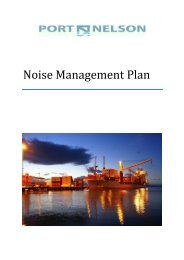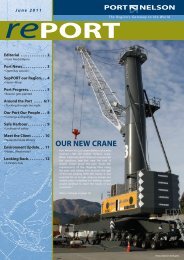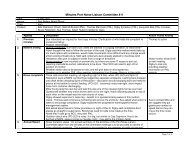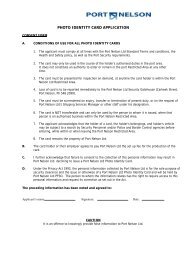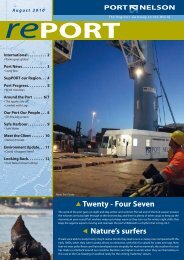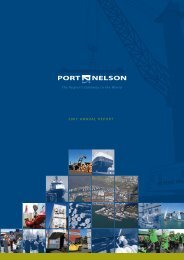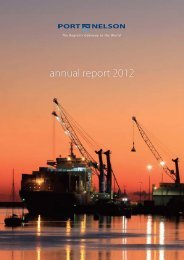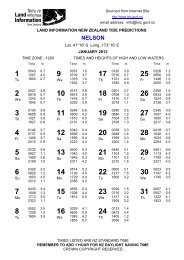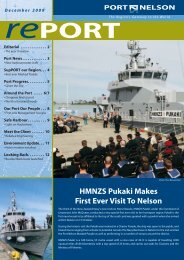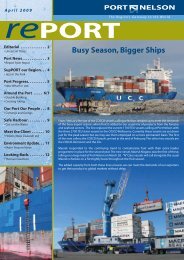August 2008(pdf) - Port Nelson
August 2008(pdf) - Port Nelson
August 2008(pdf) - Port Nelson
You also want an ePaper? Increase the reach of your titles
YUMPU automatically turns print PDFs into web optimized ePapers that Google loves.
<strong>August</strong> <strong>2008</strong><br />
rePORT<br />
Editorial .. . . . . . . . . . . . . . 2<br />
• Business Intelligence<br />
<strong>Port</strong> News.............. 3<br />
• Maersk Fuji<br />
SupPORT our Region. .. 4<br />
• Blokes Have Their Day<br />
<strong>Port</strong> Progress. ......... 5<br />
• Seen From Above<br />
Around the <strong>Port</strong> .. . . . . 6/7<br />
• On the Lines<br />
• Blessing of the Fleet<br />
Our <strong>Port</strong> Our People.. . . 8<br />
• Our Man at Anzac Bridge<br />
Safe Harbour........... 9<br />
• Fire Training<br />
Meet the Client.. . . . . . . 10<br />
• The Mediterranean Shipping<br />
Company<br />
Big Rig Visits<br />
It was a classically calm <strong>Nelson</strong> winter day when the Ensco<br />
56 drilling platform slipped through The Cut on May 30.<br />
At 143m tall and 50m wide the rig was towed into port<br />
after a slow trip down the coast from Taranaki, with the<br />
two <strong>Port</strong> <strong>Nelson</strong> tugs assisting for the final stage of the<br />
journey.<br />
The refit of the rig was a big job for Kernohan Engineering’s<br />
marine division, and for other engineering contractors.<br />
Ensco 56 berthed initially at McGlashen Quay while some<br />
underwater work was done and then moved to the #2<br />
Layup Berth for the six week re-fit. This included work on<br />
the towers by industrial abseilers from the North Island.<br />
The rig has a drilling depth of 7620 metres and facilities on<br />
board the rig include a helicopter pad and accommodation<br />
for 98 people.<br />
Ensco 56 finally left <strong>Nelson</strong> on <strong>August</strong> ? - the contracted<br />
work took a little longer than expected, and then the<br />
adverse weather that affected the whole country held up<br />
departure for a few more days.<br />
Environment Update. ..11<br />
• Get Involved<br />
Looking Back. . . . . . . . . 12<br />
• On the Rocks
<strong>Port</strong> <strong>Nelson</strong> Limited report. <strong>August</strong> <strong>2008</strong>. Page 2<br />
editorial<br />
Business Intelligence<br />
Guest editorial from Park Pittar,<br />
our Chief Commercial Officer<br />
<strong>Port</strong> <strong>Nelson</strong> has come a very long way in terms of ICT in the last four years.<br />
The Board made a bold decision to proceed with a complete system upgrade<br />
in November 2004. By June 2005 three systems had been replaced. <strong>Port</strong><br />
<strong>Nelson</strong> had a new Harbour Management system to manage the maritime<br />
movements, a new payroll system and also a new financial application. A huge<br />
effort went into implementing the systems. Full credit to all involved.<br />
Since 2005 <strong>Port</strong> <strong>Nelson</strong> has implemented an asset maintenance solution and<br />
virtualised its operating environment. Both projects have occurred in the last<br />
12 months.<br />
In addition to the new applications, extensive work has been undertaken<br />
in regard to the operational application known as Jade Master Terminal,<br />
responsible for managing the container terminal. Initiatives such as the use of<br />
‘ruggedised’ laptops in hoists and pre-noting kiosks for truck drivers to enable<br />
direct entry into the port with containers has lifted the game.<br />
The last major operational change is the development of Jade Warehousing<br />
which will enable <strong>Port</strong> <strong>Nelson</strong> to manage the majority of its break bulk (non<br />
container) cargo in a single application. What is interesting to note is that<br />
the Container, Marine and Warehousing applications are a single integrated<br />
application. <strong>Port</strong> <strong>Nelson</strong> is the first port in the world to have such a system all<br />
supplied by a single development company.<br />
“Why all the effort?” one might ask. The answer is relatively simple. The<br />
differentiating factor between a successful company and not so successful<br />
is a company’s ability to understand its business, the clients’ business and to<br />
focus on value added activities. A comprehensive management information<br />
system, sometimes referred to as Business Intelligence, is a critical factor in this<br />
regard. Customers want to know the status of their cargo at any point in time,<br />
shipping movements and be able to pre-note cargo arrivals, for example.<br />
It is our goal to increase transparency and access to the <strong>Port</strong> <strong>Nelson</strong><br />
informational environment by our customers and key border control agencies.<br />
We are well on our way in achieving that goal.<br />
Parke Pittar<br />
Lessons from Starfish<br />
Insiders, clients and even the general public<br />
might have noticed a few changes around<br />
the port in the last couple of years - and<br />
we’re not talking here about new fences or<br />
improved wharves.<br />
When Martin Byrne came on board as CEO<br />
he brought with him some lessons learnt<br />
at Flinders <strong>Port</strong>s in South Australia from a<br />
down to earth Aussie called Dr John Hill.<br />
John has a string of economics degrees<br />
and a work history that started in rural<br />
Australia when he was a lad. He’s dismissive<br />
of the term ‘management consultant’:<br />
“I just give businesses a hand to make<br />
what they do a bit easier,” he says.<br />
Two years ago John ran a two day course<br />
for the NPL leadership team, and since then<br />
he’s been back to work with management<br />
and with staff groups. He says leadership<br />
behaviour sets 70% of the culture of a<br />
business, and that culture can add to or<br />
subtract from the bottom line by 25%.<br />
A great storyteller, John engages his<br />
audience with examples that illustrate his<br />
points - the outcome of the story about a<br />
starfish being thrown back into the sea is<br />
that one person can make a difference.<br />
John has retired from university teaching,<br />
and works with a group of businesses that<br />
include BHP, Toll and Qantas - however he<br />
rates <strong>Port</strong> <strong>Nelson</strong> as one of his top clients.<br />
“The management team has really tried<br />
hard to make a change and they have had<br />
some success,” he says. “They have turned<br />
around the culture and the performance<br />
of the company - I would say most people<br />
here go home happier at the end of the<br />
working day than they did five years ago.”<br />
Parke Pittar (centre) with Financial<br />
Accountant Mason Robinson (left)<br />
and Business Analyst Hugh Stark.<br />
Management team at Awaroa.<br />
<strong>Port</strong> <strong>Nelson</strong> Limited • 10 Low Street, <strong>Port</strong> <strong>Nelson</strong> • PO Box 844, <strong>Nelson</strong>, New Zealand<br />
Tel +64 3 548 2099 • Fax +64 3 546 9015 • www.portnelson.co.nz<br />
Re<strong>Port</strong> <strong>Nelson</strong> is a triennial publication produced for <strong>Port</strong> <strong>Nelson</strong> Limited by:<br />
• <strong>Nelson</strong> Media Agency - www.nelsonmedia.co.nz • SeeReed Visual Communication - www.seereed.co.nz<br />
Thanks to Roy Skucek and Troy Dando for their assistance with photos in this issue.
<strong>Port</strong> <strong>Nelson</strong> Limited report. <strong>August</strong> <strong>2008</strong>. Page 3<br />
Mount Owen<br />
The Pacific Basin owned vessel, Mount Owen,<br />
called in <strong>Nelson</strong> in May for her first cargo of logs<br />
from New Zealand. At the same time the other<br />
new Pacific Basin ship, Benete Bay, was in Picton,<br />
also on her first voyage to New Zealand. Both<br />
vessels were chartered to load logs for <strong>Nelson</strong><br />
Forests Ltd (formerly Weyerhaeuser) and loaded<br />
approximately 56,000 JAS between them.<br />
port news<br />
<strong>Nelson</strong> Forests has entered into a freight contract<br />
with Pacific Basin, and to mark this the shipping<br />
company named the Mount Owen after <strong>Nelson</strong>’s<br />
highest peak. Mount Owen is in the Kahurangi<br />
National Park, and was one of the local sites used<br />
in the filming of Lord of the Rings.<br />
Lees Seymour, <strong>Nelson</strong> Forests’ Managing Director,<br />
went to Japan at the end of January for the<br />
launching, where his wife Melanie broke the<br />
traditional bottle of champagne over the bow of<br />
the new vessel.<br />
Maersk Fuji<br />
The first of the new vessels employed on the Southern Star Express<br />
Service, Maersk Fuji, made her maiden trip to <strong>Nelson</strong> on May 22.<br />
The Maersk Fuji was built in 2005 and heralds a new era of Maersk<br />
services in New Zealand, following a partnership between Maersk<br />
and Hamburg-Sud on American services. Maersk Fuji and her sister<br />
Maersk Fukuoka are taking on additional port calls in a re-shuffle of<br />
Maersk’s domestic feeder services that connect nine ports in New<br />
Zealand with their mainline international services.<br />
Kupe to the Rescue<br />
The tug Kupe is no stranger to rescue missions, having been involved in the 1981 rescue of the Pacific Charger from rocks at the<br />
entrance to Wellington Harbour. Her rescue mission in <strong>Nelson</strong> was a lot less dramatic.<br />
The Huria Matenga lost<br />
one side of her propeller<br />
guard while on the job,<br />
back in May. The guard<br />
struck and damaged the<br />
starboard propeller, and<br />
the tug had to be taken<br />
out of service for repairs.<br />
We engaged Seatow’s<br />
Kokiri at very short<br />
notice for a couple of<br />
jobs before a longer term<br />
arrangement was made<br />
with Westgate Taranaki<br />
to hire their recently<br />
acquired tug Kupe. A<br />
real veteran, she is one<br />
of the very early Voith<br />
propelled tugs, delivered<br />
to Wellington in 1971.
<strong>Port</strong> <strong>Nelson</strong> Limited report. <strong>August</strong> <strong>2008</strong>. Page 4<br />
supPORT our region<br />
Blokes have their day<br />
What is it with the weather? For two years in a row the Taylors’<br />
<strong>Nelson</strong> Women’s Tri has had a peachy day, while the <strong>Port</strong> <strong>Nelson</strong><br />
Blokes Day Out a week, a week or two later, has copped a<br />
downpour. Still, it didn’t deter a strong field, led for the fourth<br />
(that’s every) time by school teacher Jon Linyard.<br />
In the Vero Workmates Challenge the <strong>Port</strong> #1 team of Martin<br />
Byrne and John Hart steamed in for third; and the walk section<br />
was a <strong>Port</strong> <strong>Nelson</strong> benefit, with the B Team of Chris Williams and<br />
Daniel Shand overcoming a spirited challenge from the A team,<br />
Dick Carter and Digby Kynaston.<br />
Our marketing department won the Walking Work Mates<br />
Challenge, in a new world record time, easily dispatching its<br />
competition TBS and Infrastructure.<br />
Next year this event will run a week after the Women’s Triathlon<br />
with a mega-sport week in between, including a kids’ aquathon<br />
for Weetbix Triathletes to focus on after their event.<br />
Mitchell with the NZ flag at the opening ceremony.<br />
Saving the Planet<br />
Seven hundred child delegates from over 105 countries<br />
were represented at the Tunza International Children’s<br />
Environment conference in Norway in June. Eleven year<br />
old Mitchell Chandler from Broadgreen Intermediate<br />
represented New Zealand, thanks to support from<br />
<strong>Port</strong> <strong>Nelson</strong>.<br />
Mitchell says the environment workshops and<br />
presentations were interesting, especially SOS - Save<br />
our Seas. He says it was clear from the young delegates<br />
that every country around the world is facing the same<br />
environmental issues.<br />
“Some communities are doing lots more than us,<br />
some lots less,” he says. “Our habits need to change to<br />
preserve our world - habits made today will change our<br />
environment for tomorrow.”<br />
That’s our Val<br />
Lest we<br />
forget<br />
Anzac Day stretched to<br />
a whole weekend this<br />
year at Founders Park,<br />
where local theatre group<br />
Dramatix transformed the<br />
streets and buildings in a<br />
wartime theme. Windows<br />
were blacked out, there<br />
were battle re-enactments,<br />
trenches, bomb shelters,<br />
sing-alongs to familiar<br />
wartime tunes and a<br />
theatrical performance in<br />
the Energy Centre.<br />
<strong>Port</strong> <strong>Nelson</strong> was pleased to support this innovative concept that<br />
honoured those who gave their lives to defend our way of life,<br />
and presented those times in a way that is accessible to a new<br />
generation. The sponsorship we provided assisted production<br />
costs such as hiring of military uniforms.<br />
Chris Williams with Val at the awards’ dinner. Photo <strong>Nelson</strong> Mail.<br />
Lawn bowler Val Smith’s world-conquering efforts were<br />
recognised on the local front when she was named<br />
<strong>Nelson</strong> Sportsperson of the Year at the New Zealand<br />
Community Trust awards dinner in June. The dual world<br />
champion lawn bowler was also named for the second<br />
year as <strong>Port</strong> <strong>Nelson</strong> Ltd Sportswoman.<br />
Val’s title recognised her week-long effort in Christchurch<br />
in January when she won both the women’s<br />
singles and pairs crowns (with Jo Edwards) at the world<br />
bowls championships.
<strong>Port</strong> <strong>Nelson</strong> Limited report. <strong>August</strong> <strong>2008</strong>. Page 5<br />
port progress<br />
Seen from above<br />
This new aerial shot of the port shows the Blue Marlin at the Lay Up Berth, back in April when the huge semi-submersible was<br />
here to demobilise after floating off the Maari platform in Admiralty Bay.<br />
Main Wharf North<br />
The major upgrade of this wharf is nearing completion, with<br />
all the piling now installed, along with new bollards, and the<br />
last of the concrete pours for the deck underway.<br />
When the project is complete, next month, we will have an<br />
additional full size heavy-duty berth.<br />
Congratulations to our main construction contractor, HEB<br />
Structures (formerly Smithbridge), who have managed to<br />
get the job done to time, while working around shipping<br />
movements, including the regular visits from fuel tankers.<br />
The new wharf will allow better crane access to vessels and<br />
will be a valuable backup to the Brunt Quay container berth,<br />
which will remain our preferred berth.<br />
Better Bollards<br />
If it’s good enough for<br />
the upgraded section<br />
of Main Wharf North<br />
it’s got to be good for<br />
our other wharves.<br />
Having installed<br />
new bollards on the<br />
new wharf, we’re<br />
now in the process<br />
of replacing other<br />
key bollards. These<br />
are stronger castings<br />
than previously used<br />
and the design has been changed slightly to give improved<br />
strength. Key bollards will be progressively replaced starting<br />
with Main Wharf and those used at McGlashen Quay for the<br />
large Toyo Fuji vessels. They will be painted so they are easily<br />
identifiable.<br />
Fencing for Cars<br />
One of the downstream effects of cheaper cars has been<br />
the problem of random dumping of old vehicles that have<br />
no market value. Council staff deal with this daily at city<br />
reserves, and we were getting our share of dumped cars in<br />
the Akersten Street log yard. The yard has now been fenced to<br />
put an end to this problem, and to enhance health and safety<br />
for port operators and the public, as well as cargo security for<br />
our clients.
<strong>Port</strong> <strong>Nelson</strong> Limited report. <strong>August</strong> <strong>2008</strong>. Page 6<br />
around the port...<br />
On the Lines<br />
Pulling wet lines out of the water is heavy job, and if you can take some of the effort out of it, that’s got to be good. We had a<br />
look at how other ports handle lines - some mount a capstan on the back of a flatbed truck, but our workshop team developed<br />
a system that uses an electric motor-driven capstan which can be attached to a forklift. The greater manoeuvring capability of a<br />
forklift will be beneficial and trials with a prototype have been quite successful. When final modifications are made we’ll continue<br />
the evaluation and we look forward to taking some of the heavy work out of this job and making the task safer for our people.<br />
Crane Training<br />
Austria - it’s a land of mountains, music<br />
and machinery. We sent Grant Cottle and<br />
Craig Terris to Nenzing where the Leibherr<br />
cranes are produced, for an update on<br />
the technical side of these machines.<br />
They came back with praise for the product<br />
and a good understanding of Liebherr’s<br />
design and construction methods and<br />
intentions. Their weeklong course focused<br />
on the hydraulics, electrical systems and<br />
safety features of the cranes.<br />
It’s a decade since our units were<br />
manufactured, and there have been<br />
modifications since then. Grant and Craig<br />
will be introducing some of their new<br />
know-how to enhance the reliability of<br />
our two Liebherrs. For example, drivers<br />
are now giving the winches time to warm<br />
up to avoid a repeat of the gearbox failure<br />
we had a couple of years ago.<br />
Craig says Nenzing is a very small village<br />
where 1000 people work in the Liebherr<br />
factory - 120 of them as apprentices.<br />
Temperatures were in the thirties while<br />
they were there, but there was still snow<br />
on the mountains.
<strong>Port</strong> <strong>Nelson</strong> Limited report. <strong>August</strong> <strong>2008</strong>. Page 7<br />
Blessing of the Fleet<br />
After eight years, calm and sunny winter days had come<br />
to be the norm for the annual Blessing of the Fishing Fleet.<br />
Not so this year when it was rained out on the scheduled<br />
date and was restaged a fortnight later on <strong>August</strong> 2.<br />
Our own piping port worker Robbie Duncan did the<br />
honours with My Home, the children sang, the doves<br />
flew and the fleet was blessed. We are proud to support<br />
this annual reminder of the importance of fishing to the<br />
<strong>Nelson</strong> region and commemoration for those who have<br />
lost family members in this vital industry.<br />
...and beyond<br />
Liz Moves On<br />
June was goodbye time for Liz Grant - she and her mobile<br />
phone were something of a fixture around the port in her<br />
agent’s role with McKay Shipping Ltd. Liz has moved within<br />
the company to become Manager Central Regions, based<br />
in Wellington, so we’ll still see her in <strong>Nelson</strong> from time to<br />
time. All the best Liz, and many thanks for your years of input<br />
as one of the longest serving members of the <strong>Port</strong> <strong>Nelson</strong><br />
Environment Committee.<br />
Singapore Stevedoring<br />
Stevedoring Operations Manager, Digby Kynaston flew off<br />
to the <strong>Port</strong> of Singapore in May, spending a few days on a<br />
training programme sponsored by the Singapore Ministry of<br />
Foreign Affairs under their Singapore Cooperation Programme.<br />
It was attended by 28 participants, representing 25 different<br />
countries worldwide, including Rwanda and Bhutan, two<br />
landlocked countries considering developing inland ‘ports’.<br />
The course covered container ship and yard operations,<br />
port equipment maintenance, navigation and traffic control,<br />
IT applications, pricing of port services, container freight<br />
stations, and measures of port productivity.<br />
Business Analyst Hugh Stark is satisfied the old PC’s are ready for their new life.<br />
Computers for the Congo<br />
When our computers get past their use-by-date we usually strip<br />
them down and send them away for re-cycling or destruction.<br />
Through a contact of our staff development consultant<br />
John Hill, we recently dispatched seven old machines and<br />
a variety of other gear to a charitable organisation based in<br />
Melbourne. They sent them on to the Democratic Republic<br />
of the Congo for use in schools, where the pupils have never<br />
before been able to access such equipment. It is good to see<br />
these machines get some further use from people who will<br />
really appreciate them.<br />
Digby has come back with a number of ideas he will be working<br />
to put in place - these include getting more staff input on<br />
quality, some new concepts to improve training and looking<br />
into a system of staff rewards for safety enhancements.
our port our people<br />
Photo: CPL Chris Weissenborn, RNZAF<br />
Our man at Anzac Bridge<br />
When the Prime Minister, Helen Clark went to Sydney to dedicate the<br />
new statue of a World War I soldier on Sydney’s Anzac bridge - our<br />
Financial Accountant, Mason Robinson was there too. As part of his<br />
territorial duties he was in the NZ Defence Force guard and was selected<br />
to play The Last Post at the dedication.<br />
“It was a very moving ceremony,” he says. “Being live on Australian<br />
television added to the significance of the event.”<br />
The Anzac Bridge crosses the harbour to Glebe Point and the new kiwi<br />
statue stands on the western side of the bridge, facing the Australian<br />
digger that was placed there in 2000.<br />
Toast and Titters<br />
There was plenty of laughter as our leadership team gained new skills in<br />
the art of presentation with a recent evening course run over six weeks<br />
by Toastmasters.<br />
Each week participants had a speech to present to the group, with a<br />
focus on various aspects of public speaking, such as voice projection,<br />
structure, vocal variety and body language. Some of the more memorable<br />
moments included Shane King’s demonstration of vocal variety via Bad<br />
Jelly, Digby Kynaston’s scene setter for a talk on Sheep Farming - where<br />
he threw eggs at one of the Toastmasters, Karen Barnett’s speech on<br />
her love of tobacco, Suzanne’s oration on her admiration for the Regular<br />
Kiwi Bloke, Phil Francois on the Moulin Rouge and all of Troy Dando’s<br />
speeches on various aspects of fishing!<br />
Bye to Robin<br />
It’s not every company that would be so supportive in losing a<br />
valued staff member to a business that could be seen as competition.<br />
Stevedoring Supervisor Robin Harris, who has been with PNL for 16<br />
years is off to Centre<strong>Port</strong> in Wellington, and he’s thrilled at the support<br />
he has had from management for his decision. “They see it as career<br />
development and I know my new role in ship planning at Centre<strong>Port</strong><br />
will broaden my horizons,” Robin says. “<strong>Nelson</strong> will always be my home<br />
and I look forward to coming back to <strong>Port</strong> <strong>Nelson</strong> at some time in the<br />
future.”<br />
We wish Robin and his family all the best for the future and thank him<br />
for his contribution to TBS and PNL over the years.<br />
<strong>Port</strong> <strong>Nelson</strong> Limited report. <strong>August</strong> <strong>2008</strong>. Page 8<br />
Coming and Goings<br />
Welcome to Tina<br />
Rajino, who takes over<br />
from Athena as the<br />
Administration Assistant<br />
in the Workshop. Tina is<br />
originally from Indonesia,<br />
but with a Kiwi partner<br />
and family in <strong>Nelson</strong> she’s<br />
finding her new outdoor<br />
lifestyle suits her very<br />
well. Tina worked with<br />
the UN in Sierra Leone<br />
and since arriving in <strong>Nelson</strong>, worked the past<br />
fruit season with ENZA. Tina and her partner<br />
Andrew have two teenage sons.<br />
Jeremy Salton is our new QuayPack Foreman.<br />
He comes to us from Randle Distribution, which<br />
made him a regular visitor to <strong>Port</strong> <strong>Nelson</strong>.<br />
Jeremy lives in Richmond with his wife Sharon<br />
and three children and is into softball, rugby<br />
and mountain biking.<br />
Jeremy replaces<br />
Andy Farmer who<br />
is enjoying his new<br />
role as Quaypack<br />
supervisor and the<br />
daily challenges that<br />
go with meeting tight<br />
deadlines, having<br />
enough boxes on<br />
hand and the cargo<br />
to fill them!<br />
Helen Jemson is the new Labour Co-ordinator<br />
for the Stevedoring Department. She has been<br />
working for Pacifecon Construction Reports,<br />
providing subscribers with information on<br />
building projects. Helen grew up in <strong>Nelson</strong> and<br />
returned here in 2002. She has lived in Canada,<br />
where she completed a PhD in Chemistry. Helen<br />
and her husband James live in Richmond and<br />
have two teenage sons.<br />
Sally McCue is the new face at the Security<br />
Gate, or rather the familiar face as she’s been a<br />
casual stevedore over the past nine years and a<br />
reliever at the gate and on security.<br />
It was (sort of ) goodbye to Geoff Shepard at the<br />
end of July, after 24 years when he ‘Sheparded’<br />
the company into the computer age. Geoff<br />
is continuing as a contractor until we find<br />
someone to take his place, and he will still be<br />
getting his share of port life as a casual on the<br />
tugs, launch and lines crew.<br />
Infrastructure Manager Dick Carter has signalled<br />
his resignation at the end of the year. He says<br />
he always intended to do five years with <strong>Port</strong><br />
<strong>Nelson</strong>, but is surprised at how quickly the time<br />
has gone. We’ll say our official farewell to Dick in<br />
the next issue of Re<strong>Port</strong>.
<strong>Port</strong> <strong>Nelson</strong> Limited report. <strong>August</strong> <strong>2008</strong>. Page 9<br />
Fire Training<br />
A fire extinguisher is not much<br />
use hanging on the wall - or in the<br />
hands of a person who doesn’t<br />
know how to work it. With this<br />
in mind we offered a fire training<br />
course to all staff, and had a great<br />
response from everyone from<br />
forklift drivers to administration. A<br />
local safety contractor covered the<br />
theory behind fire safety measures<br />
and the use of hand-held portable<br />
extinguishers - and then it was off<br />
outside to give it a go.<br />
safe harbour<br />
Foaming Fire Fighters<br />
The Golden Hour<br />
In a medical emergency time is of the essence.<br />
Survival rates drop by up to ten percent<br />
every minute without CPR and defibrillation.<br />
If emergency services are held up for any<br />
reason it is even more important that we are<br />
able to take the first lifesaving steps on site.<br />
Fuel unloading at Main Wharf North will be safer with two foam<br />
monitors. These can be activated remotely, as an immediate<br />
response to prevent fire if there is an oil spill, or to put a fuel<br />
fire out. Project Engineer, John Hart, says once activated, each<br />
monitor head rotates through a prescribed arc, bringing in<br />
water from the mains to mix with the foam in the storage<br />
tank. The monitors provide immediate action before the fire<br />
service arrives and were installed following an audit of safety<br />
systems around the country by the oil industry.<br />
Safety for all<br />
For this reason we have invested in an<br />
Automated External Defibrillator that will<br />
be kept at the Security Gatehouse. Our<br />
First Aid staff are being trained in the use<br />
of the defibrillator and anyone else who is<br />
interested in the training should contact<br />
Safety Advisor, Jim Lane.<br />
Security Supervisor Bill Homan just needs a patient and<br />
he’s ready to go - just like on ER!<br />
It’s a record! - We didn’t make 200 but we did get to<br />
166 days on our Lost Time Injury board before we had<br />
a recordable injury. There were choccy treats all round<br />
at the milestones of 100 and 150. Even after the minor<br />
injury that put us back to zero we are still ahead of our<br />
position this time last year. So for more chocolate and a<br />
safer workplace - let’s all be super vigilant.<br />
The potential for conflict between recreational boaties and commercial vessels is one of the hazards identified in a risk<br />
assessment of the port, undertaken by independent consultant John Riding of Marico Marine. The risk assessment, jointly<br />
commissioned by <strong>Port</strong> <strong>Nelson</strong> Ltd and the <strong>Nelson</strong> City Council, and approved by Maritime New Zealand, is the first stage in<br />
compliance with the New Zealand <strong>Port</strong>s and Harbours Safety Code.<br />
Other hazards identified in the report included collisions, groundings, swampings, floating debris and mooring failures.<br />
Mr Riding recently addressed the City Council, which has statutory responsibility for providing and regulating navigational safety<br />
in the harbour. He outlined the options available to the council regarding the harbourmaster position, currently held by our Marine<br />
Operations Manager, Roy Skucek. While Mr Riding favoured maintaining the status quo, he signalled the need to bolster the position<br />
with additional time and resources to focus on the increasing volume of recreational activity in the harbour.<br />
Regional councils and port authorities around New Zealand are developing Safety Management Systems to comply with the<br />
recommendations of the New Zealand <strong>Port</strong>s and Harbours Safety Code.<br />
Keeping Safe<br />
We welcome any suggestions or information to make <strong>Port</strong> <strong>Nelson</strong> a safer working environment.<br />
If you have a name you would like added to our mailing list, please let us know.
<strong>Port</strong> <strong>Nelson</strong> Limited report. <strong>August</strong> <strong>2008</strong>. Page 10<br />
meet the client<br />
The Mediterranean Shipping Company<br />
A privately owned, family based shipping line, founded in Belgium in 1970, has rapidly grown to<br />
become the world’s second largest container carrier. Kevin Inder, the Mediterranean Shipping Company’s<br />
Regional Manager Southern, says this growth has been achieved ‘organically’ rather than<br />
through acquisitions or mergers, and he says the company still retains its flat management structure.<br />
What does this mean to us here in <strong>Nelson</strong>?<br />
For one thing MSC can respond quickly to market changes<br />
- as we saw here recently when the MSC-Maersk joint vessel<br />
sharing service separated earlier this year. MSC moved to fill<br />
the gap, stepping up their fortnightly service with MSC Edith<br />
to a weekly one, with the extra vessel, MSC Frisia.<br />
Managing Director, Kevin Clarke launched MSC Australia from<br />
a small office in Sydney with a staff of two. New trade routes,<br />
bigger and newer vessels, and staff increased steadily and in<br />
1996 a New Zealand office opened in Auckland, followed in<br />
September 1998 with a one man (that was Kevin Inder) office<br />
in Christchurch.<br />
The line commenced servicing <strong>Nelson</strong> in<br />
2002 and quickly built up a base of clients<br />
that represent all of the region’s main exports,<br />
now catered for by direct weekly vessel calls.<br />
There is seafood going to Asia and Europe,<br />
processed wood - both MDF and LVL - from <strong>Nelson</strong><br />
Pine Industries, sawn timber headed for South<br />
East Asia, Asia and China, meat from the Alliance<br />
plant, and apples shipped in reefer containers to<br />
markets in Europe.<br />
MSC values the facilities and central location of<br />
<strong>Port</strong> <strong>Nelson</strong> as a base for storage and servicing of<br />
empty containers.<br />
“This ties in with our clients’ use of QuayPack for<br />
vanning the cargo and with the Jade IT tracking<br />
system,” Kevin says. “<strong>Port</strong> <strong>Nelson</strong> works hard to<br />
ensure the cargo remains in the region (rather<br />
than being trucked out) and we see a good future<br />
here with the global service we can provide to<br />
local exporters.”<br />
“We wanted to maintain the support of our client base here<br />
in <strong>Nelson</strong>,” Kevin says, “and we believe that the <strong>Nelson</strong> region<br />
has a good future with its strong export base.”<br />
Southern Region Sales Manager, Simon Chan, adds that the<br />
new service offers more flexibility and regularity in available<br />
space for shippers.<br />
<strong>Nelson</strong> is the final New Zealand call on MSC’s Butterfly service,<br />
which comes up the East Coast via <strong>Port</strong> Chalmers, Lyttelton<br />
and Wellington, then calls at <strong>Port</strong> <strong>Nelson</strong> before making the<br />
trans-Tasman trip in three days to berth in Sydney. Cargo<br />
shipped ex-<strong>Nelson</strong> then links with global markets via MSC’s<br />
other services to Japan, Korea, China and Taiwan and via<br />
Singapore to the Middle East, India, Mediterranean, Europe<br />
and the UK. The line also offers two other trans-Tasman<br />
schedules ex-New Zealand ports.<br />
The MSC headquarters is now based in Geneva, with<br />
the Australasian HQ conveniently sited in Fremantle.<br />
The Australasian side of the MSC story started in 1989, when
<strong>Port</strong> <strong>Nelson</strong> Limited report. <strong>August</strong> <strong>2008</strong>. Page 11<br />
Spraying water<br />
We’re spraying in style these days with a revamped water<br />
cart. The old tank was past its best, and the existing truck<br />
was retro-fitted with a stainless steel tank, fitted with a<br />
petrol driven water pump and a spray boom. The nozzles on<br />
the new unit send out a finer spray mist, that means we can<br />
dampen down dust more effectively, and use less water.<br />
Noise progress<br />
The <strong>Port</strong> Noise Variation hearings were held in May with<br />
a follow-up day in July. The panel of three commissioners<br />
included national experts in resource management, law<br />
and noise. It is hoped the mitigation work on houses and<br />
noise management package that is adopted will be the<br />
best solution for the <strong>Nelson</strong> situation - of residential homes<br />
in close proximity to a working port. Meanwhile, offers to<br />
provide insulation to the 11 most affected houses have now<br />
been made, and we continue to work at reducing the noise of<br />
our operations.<br />
Limits on fumigant use<br />
The Environment Court issued its final decision on the use<br />
of the fumigant methyl bromide at <strong>Port</strong> <strong>Nelson</strong> in June.<br />
Earlier this year an interim decision allowed the fumigation<br />
company Genera to carry on with fumigations at the port, as<br />
long as a re-capture system is introduced.<br />
Marine Biodiversity<br />
<strong>Port</strong> <strong>Nelson</strong> is participating in the Coastal and Marine Working<br />
group set up to develop action plans for the <strong>Nelson</strong> City<br />
Biodiversity Strategy, along with NIWA, DoC and iwi. It is<br />
hoped our ongoing research as part of our water quality<br />
and dredging monitoring will be of use to this group, and<br />
that it will help us to include biodiversity concerns on port<br />
operations or future developments.<br />
From Seed to Spoon<br />
We participated in a workshop held by ZESPRI on the carbon<br />
footprint of a kiwi fruit from ‘seed to spoon’. To meet the<br />
demands of UK supermarkets exporters are increasingly<br />
asked to supply information on the emissions content of a<br />
product over its whole lifecycle. The direct emissions from<br />
the port footprint are small in themselves, but our links to<br />
shipping and exporters give us a key role.<br />
Inspiration from Aussie<br />
Environmental Officer,<br />
Frances Woodhead<br />
visited the <strong>Port</strong>s of<br />
Brisbane and Townsville<br />
as part of a workshop<br />
on Environmental<br />
Management in <strong>Port</strong>s.<br />
Highlights were visiting<br />
state-of-the-art green<br />
buildings at the port,<br />
water-saving technology,<br />
and a specially constructed bird roost in a new reclaimed<br />
area, as well as holistic management techniques for stormwater<br />
pollution prevention.<br />
Get involved!<br />
A trip around Townsville <strong>Port</strong><br />
Aussie style - with a beer!<br />
At the <strong>Port</strong> <strong>Nelson</strong> Environment Committee meeting<br />
in June there was a discussion on environmental<br />
input into the <strong>Port</strong> <strong>Nelson</strong> <strong>2008</strong> Strategic Plan, the<br />
new fumigation protocols and a presentation from<br />
Transition Town <strong>Nelson</strong>, a community initiative<br />
working on projects from transport to food growing,<br />
to assist in the ‘transition’ from a ‘peak oil’ economy.<br />
environment update<br />
Lobby group, Campaigners Against Toxic Sprays, had called<br />
for a chronic standard to be imposed because it believed<br />
health effects sometimes took many years to appear.<br />
In its final June decision, the court imposed a new chronic<br />
limit to be included in the <strong>Nelson</strong> City Council’s air quality<br />
plan allowing a limited number of container fumigations<br />
without recapture.<br />
The ruling is a good outcome for public health and concerns<br />
about ozone depletion. Although it will be some time<br />
before the decision is fully implemented, the first of the new<br />
technology is expected to be in place soon. It has also been<br />
announced that Environmental Risk Management Authority<br />
(ERMA) will be having a national enquiry into the use of<br />
Methyl Bromide in New Zealand.<br />
We are still looking for port area residents to join<br />
the committee, which is made up of representatives<br />
from the city council, DoC, port users, environmental<br />
groups and neighbours. We meet around six times a<br />
year on a Wednesday lunchtime, to provide dialogue<br />
between interested parties and input to <strong>Port</strong> <strong>Nelson</strong><br />
on environmental management. Please email frances.<br />
woodhead@portnelson.co.nz or phone 5393861 if you<br />
would like to know more.<br />
Re<strong>Port</strong> is Green<br />
In line with our environmental policies Re<strong>Port</strong> uses elemental<br />
chlorine free paper produced from sustainably managed forests.<br />
Re<strong>Port</strong> is printed with vegetable based inks.
<strong>Port</strong> <strong>Nelson</strong> Limited report. <strong>August</strong> <strong>2008</strong>. Page 12<br />
looking back<br />
On the Rocks<br />
Imagine the drama there would be today if a ship ran aground on Rocks Road.<br />
The Union Company steamer, Hawea aground on the <strong>Nelson</strong> foreshore in 1886. Kingsford and Baigent, Museum of Wellington Collection.<br />
In 1886 shipwrecks were more common, but there was still plenty of consternation from residents near the<br />
old harbour entrance around Haulashore Island, when they awoke on March 30 to see the Union Company<br />
steamer Hawea with her nose on the beach near the sea wall.<br />
It was a fine, clear, starlit night and the Captain, Joseph<br />
Hansby, said the course was the one he always steered when<br />
coming into <strong>Nelson</strong> and that he had come in earlier on the<br />
tide twice before.<br />
“The only way I can account for the accident is that she<br />
took a steer in the strong eddy and did not answer her<br />
helm sufficiently quickly. The engines were working properly.<br />
We were coming dead slow. As soon as she touched the<br />
engines were reversed and put full speed astern... but this had<br />
no effect on her,” He told the <strong>Nelson</strong> Evening Mail.<br />
The 25 passengers were disembarked onto the beach and the<br />
cargo was redistributed from the forehold to the stern, but<br />
there was no budging the stranded vessel on that tide.<br />
The Hawea stayed on the beach all day, and as the evening<br />
high tide approached the crowd grew. The <strong>Nelson</strong> Evening<br />
Mail somewhat whimsically suggested that if cabmen had<br />
their say ‘there would be a vessel ashore at the harbour<br />
entrance two or three times a week at least for they were kept<br />
pretty busy conveying spectators to the Rocks from the town<br />
as the time for high water approached’.<br />
Another Union Company ship, the Mahinapua tried to drag<br />
the Hawea into deeper waters, but succeeded only in breaking<br />
three towlines, and was dispatched on her journey to the<br />
West Coast.<br />
The Hawea remained aground until the following morning,<br />
when she spontaneously floated off on the high tide. Thanks<br />
to the soft shingle of the beach she was undamaged.<br />
An enquiry held on the stranded vessel while she was still<br />
aground found no one to be at fault. The Mail reported:<br />
'the grounding of the steamer was one of those accidents<br />
which it is said it is impossible for the best regulated families<br />
to avoid’.<br />
The Hawea was a 66 metre single screw steamer built in<br />
Scotland in 1875, and able to carry 92 passengers. She was<br />
speedy in good conditions and in 1876 steamed from Picton<br />
wharf to Barrett Reef, Wellington in 3 hours 20 minutes.<br />
The vessel had a short but eventful career and sank after<br />
striking a submerged object while coming into New Plymouth<br />
(from Onehunga) in 1888. The Hawera and Normanby Times<br />
reports that the ‘mails were landed all dry’ and the passengers<br />
were taken by boat to the wharf where arrangements were<br />
made for them to continue by train. There were two race<br />
horses on board, Allegro, which had just won the Auckland<br />
steeplechase, slipped her sling and was drowned, while the<br />
other horse, Armourer, made it safely to shore.



